
10 early autumn flowering perennials
Discover our selection!
Contents
The arrival of autumn does not mean the end of flowering in the garden! Some perennials extend their season and continue to produce beautiful flowers in early autumn: asters, Japanese anemones, chrysanthemums, sedums, saxifrages… not to mention the grasses! Feel free to combine these perennials to create stunning flower beds. You can accompany them with the beautiful red-orange hues of autumn foliage (Japanese maples, Parrotia persica, Liquidambar, winged euonymus, bloodtwig dogwood…) and decorative berries (callicarpa, euonymus, viburnum…). Discover our selection of the 10 most beautiful perennials that bloom from late September to early October until mid-November… to enjoy a lovely transition into autumn/winter.
Asters
With their numerous small star-shaped flowers, resembling daisies or buttercups, Asters are irreplaceable for brightening up autumn borders! They produce capitula made up of tiny yellow tubular flowers at the centre, surrounded by many ligulate flowers that look like petals. These come in shades of white, pink, mauve, or blue, depending on the variety. Asters are very hardy plants that thrive in full sun in ordinary, cool, and well-drained soil. Their light and airy flowering adds a lovely volume effect to borders!
For autumn flowering, the choice is vast: you can select from Aster novi-belgii and Aster novae-angliae, which are perfect for colourful mixed borders, or from Aster cordifolius and Aster ericoides, whose airy flowering will easily find its place in a naturalistic garden, as well as Aster dumosus or Aster amellus… We recommend, for example, the Aster cordifolius ‘Blue Heaven’, which offers very beautiful light blue flowers, the Aster novae-angliae ‘Rosa Sieger’, with pink flowers, the Aster ericoides ‘Esther’, with soft pink-mauve flowers, or the Aster novae-angliae ‘Herbstschnee’, with white flowers.
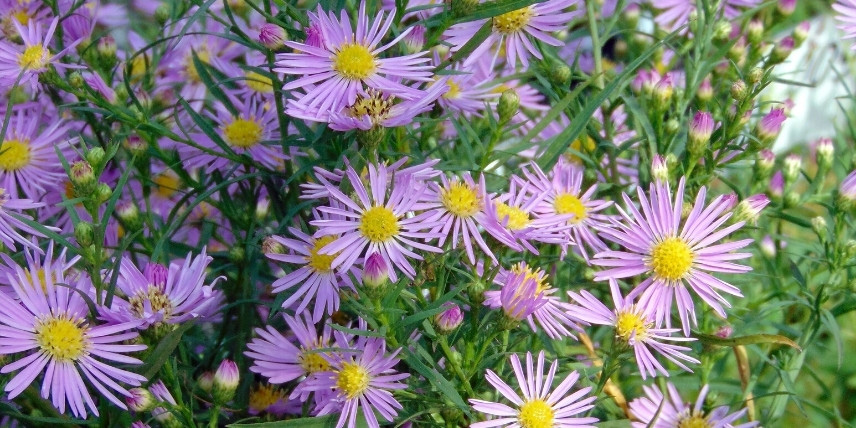
The delicate soft pink-mauve flowers of Aster ericoides ‘Esther’
→ To learn more, check out our complete guide on Asters
Read also
7 superb flowerbeds for autumnJapanese Anemones
Japanese Anemones are among the most beautiful perennials of late summer and early autumn. Their style is very simple and natural, yet elegant. They produce single or double flowers, well-opened, formed of a heart of yellow stamens surrounded by graceful petals, in white, pink, or purple. Japanese anemones are easy to grow, thriving in partial shade, in cool, humus-bearing soil.
For flowering between August and November, we particularly recommend the varieties ‘Pamina’, which offers double pink flowers and reaches up to 80 cm in height, ‘Little Princess’, with single pink flowers that do not exceed 50 cm in height, or ‘Pretty Lady Maria’, which has white flowers. Also discover the beautiful anemone ‘September Charm’, which offers a very generous flowering, with flowers of a lovely pearly pink that can reach up to 1 m in height.
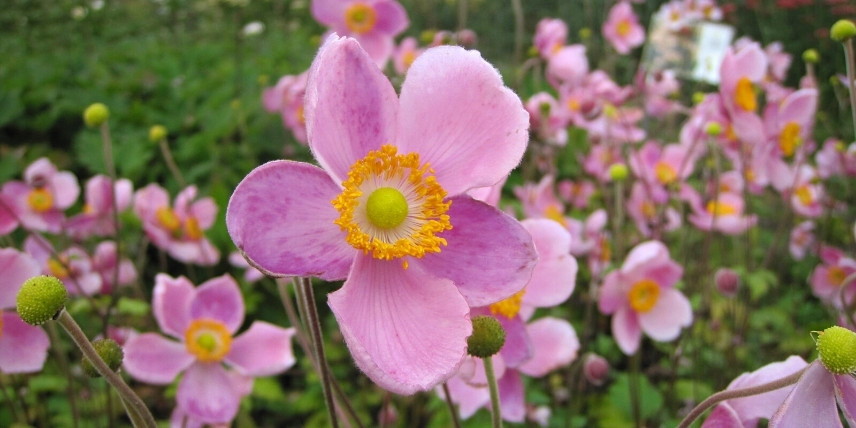
The delicate flowering of Anemone hupehensis ‘Little Princess’
→ To learn more, discover our complete guide on Japanese Anemones
Discover other Late flowering perennials
View all →Available in 0 sizes
Available in 0 sizes
Available in 0 sizes
Available in 0 sizes
Available in 0 sizes
Available in 0 sizes
Available in 0 sizes
Available in 0 sizes
Available in 0 sizes
Chrysanthemums
Once confined to the decoration of cemeteries, the chrysanthemum truly deserves its place in the garden! This beautiful autumn perennial offers a vibrant flowering display, with rounded flowers that are either single or pompom-shaped, made up of numerous petals in warm tones: yellow, orange, red, pink… There is an endless variety of types available, so you won’t have trouble finding ones that will complement your borders. The chrysanthemum is quite hardy and thrives in full sun, in ordinary, well-drained soil.
We recommend, for example, the ‘Brennpunkt’ chrysanthemum, with its very double deep red-copper flowers, the ‘Citronella’ chrysanthemum, which features bright yellow pompom flowers, the ‘Herbstbrokat’ chrysanthemum with bronze-orange flowers, or the ‘Poésie’ chrysanthemum, whose initially white flowers turn a soft yellow.
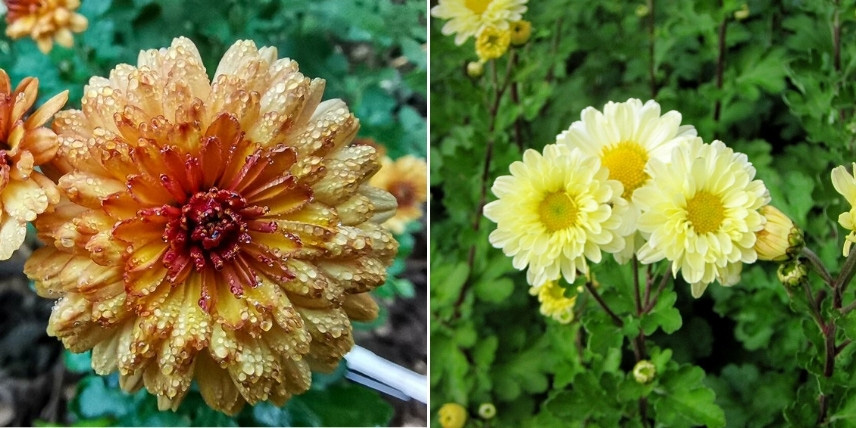
The flowers of the ‘Herbstbrokat’ (photo cattan2011) and ‘Poesie’ chrysanthemums
→ To learn more, discover our guide on chrysanthemums
Read also
Create a beautiful autumn gardenMiscanthus
Native to Asia, Miscanthus is a beautiful structural grass, impressive in stature, also known as Chinese Reed or Eulalia. It forms large, upright clumps made up of long, fine, flexible leaves that are very graphic in appearance. It flowers in late summer or early autumn, between August-September and November, producing fan-shaped spikelets that bloom above the clump. The spikelets have beautiful silvery, golden, or reddish-brown hues. Depending on the variety, Miscanthus can reach heights of between 60 cm and 3 m. The leaves of Miscanthus are deciduous; they dry out in autumn but remain on the plant, providing decorative interest for much of the winter.
Miscanthus adapts to all types of soil but prefers a sunny location. It is easy to grow and not very susceptible to diseases. It will easily find its place in a naturalistic and wild garden, as well as in a contemporary garden or mixed border.
For early autumn flowering, we particularly recommend Miscanthus giganteus and Miscanthus sinensis, which comes in many varieties, some with striate foliage (Miscanthus sinensis ‘Zebrinus’, Miscanthus sinensis ‘Gold Bar’…). Similarly, some varieties have foliage that takes on beautiful autumn colours.

The variegated foliage and floral spikes of Miscanthus sinensis ‘Zebrinus’
→ To learn more, discover our complete guide on Miscanthus
Saxifrages
Saxifrages are beautiful little perennials that form rosettes of leaves close to the ground, above which rise small star-shaped flowers, white or pink. Depending on the species, these flowers can be solitary or grouped in very light, airy inflorescences. They are mostly mountain plants, growing on rocky walls, cliffs, or in woodlands. They are quite hardy and resistant to diseases, mainly fearing stagnant moisture.
For flowering from September to November, choose Saxifraga cortusifolia or Saxifraga fortunei. These are Asian species that thrive in shaded woodlands or rock gardens, in cool, light soil rich in humus. They have larger leaves than other species and offer a light, starry flowering. Some are very unique, such as the ‘Black Ruby’ saxifrage, with black leaves and pink flowers! You can pair them, for example, with the decorative foliage of heucheras, carex, ivy, and ferns.
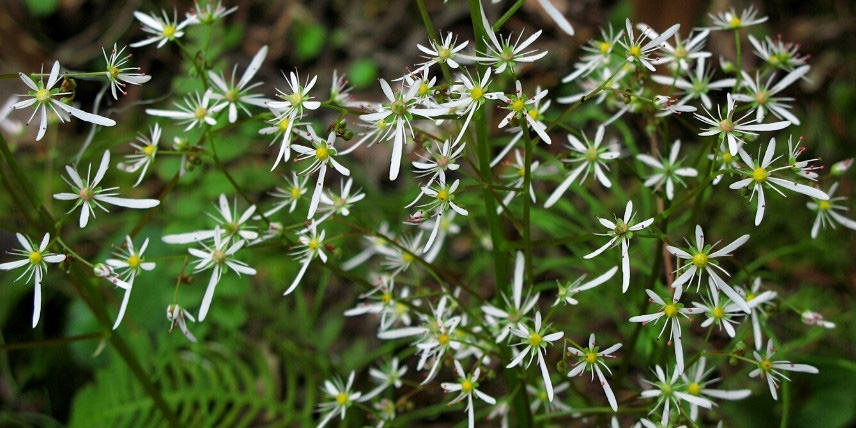
The light and airy flowering of Saxifraga fortunei (photo Tanaka Juuyoh)
→ To learn more, discover our complete guide on saxifrages
Sedums
Sedums are succulent plants, equipped with thick leaves that allow them to store water and minerals, enabling them to withstand drought. They are ideal plants for a low-maintenance garden, economical in water and fertiliser. They offer a vast diversity, with numerous species showcasing a variety of shapes and colours. For early autumn flowering, we recommend upright sedums, which provide large leaves topped with dense, rounded inflorescences (unlike small creeping sedums, which do not exceed 10-15 cm in height). Discover, for example, the variety ‘Stardust’, with white flowers, ‘Herbstfreude’, with pink flowers, and ‘Thunderhead’, with purple flowers and dark leaves. They will easily find their place in a perennial border or along a path, in full sun and in perfectly drained soil to protect their roots from stagnant moisture.

The pink flowers of Autumn Stonecrop or Sedum spectabile ‘Carl’
→ To learn more, feel free to check our guide on sedums
Ceratostigma
Ceratostigma, formerly known as Plumbago, includes perennial plants and shrubs that bear beautiful gentian blue flowers with five petals. For early autumn flowering, choose the Ceratostigma willmotianum, a small shrub with a soft, spreading habit, reaching 1 m in height and 1.5 m in spread. It produces lovely blue flowers from September to November, extended by a reddish tube. It is hardy down to -10 °C and thrives in full sun, in well-drained, rather stony, neutral to calcareous soil. You can also choose the Ceratostigma griffithii, a small shrub with a spreading habit that does not exceed 80 cm in height, with red stems bearing evergreen green leaves marginate with purple, on which its intensely blue flowers stand out beautifully. It also enjoys warm exposures and well-drained soils, making it perfect for dressing a bank or rockery.
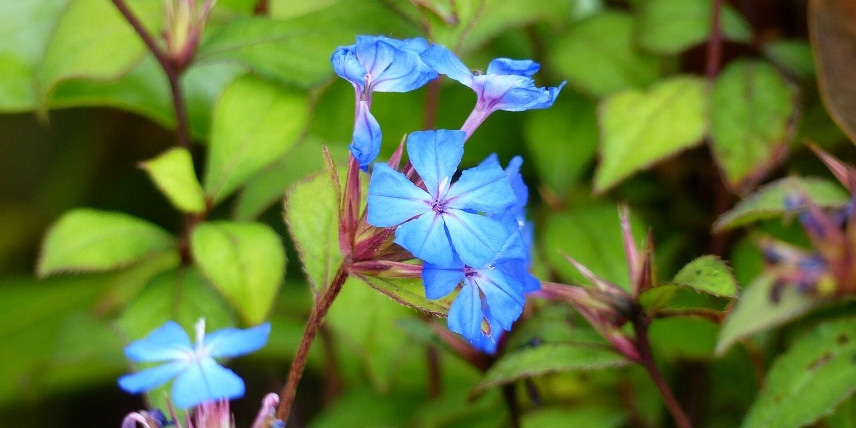
Ceratostigma willmottianum produces very beautiful blue flowers
→ To learn more, discover our complete guide on ceratostigma
Schizostylis
The Schizostylis coccinea, also known as the Kaffir Lily, is a beautiful perennial native to South Africa, valued for its star-shaped red flowers. It produces open cup-shaped flowers, 2 to 5 cm in diameter, very elegant, made up of six fine petals. This vigorous plant develops from a suckering stump and forms long, narrow, ribbon-like, medium green leaves, which are evergreen in regions with a mild climate. It gradually spreads through its rootstock, allowing it to slowly colonise the space. Although the species type bears red flowers, there are other varieties, such as ‘Mrs Heggarty’, appreciated for its very romantic soft pink flowers, and ‘Alba’, which is distinguished by its white flowers, perfect for creating a chic and refined atmosphere.
The Schizostylis thrives in full sun, in rich, cool to moist soil. It is perfect for enhancing the banks of a pond, but also fits well in autumn borders, and can also be grown in pots. It is hardy down to -10 °C.
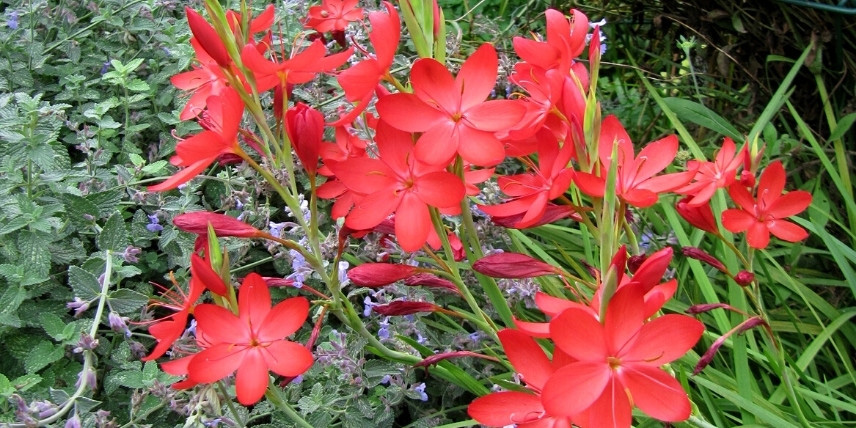
The scarlet red flowers of Schizostylis coccinea (photo Leonora Enking)
→ To learn more, discover our complete guide on Schizostylis
Helianthus
Helianthus is an exceptional tall perennial that brings brightness to an autumn border! It truly deserves its nickname of perennial Sun. This cousin of the sunflower reaches heights of between 1.30 m and 2 metres, depending on the variety. At the top of its stems, it bears large golden yellow flowers, shaped like daisies, which can be single or double, depending on the number of petals they have. It is a vigorous plant, perfectly hardy (down to -20 °C) and easy to grow. It thrives in full sun, preferably in cool, well-draining soil, although it will accept growing in almost any location. If possible, place it in a sheltered spot to protect its tall stems from wind damage. Regarding varieties, we recommend the Helianthus decapetalus ‘Plenus’, which has beautiful fully double flowers, as well as the Helianthus salicifolius, with single flowers. Integrate them into a mixed border or a naturalistic bed alongside grasses and perennials with a soft habit.
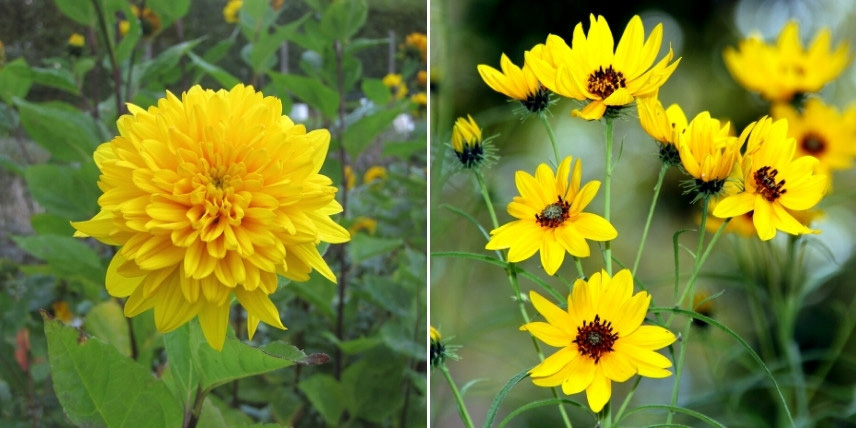
The double flowers of Helianthus decapetalus ‘Plenus’ and the single flowers, with a very natural style, of Helianthus salicifolius (photo Manuel M.V.)
→ To learn more, discover our complete guide on helianthus
Muhlenbergia capillaris
Muhlenbergia capillaris is a grass that produces stunning floral spikes from September to November, very airy, held above the foliage. They have a lovely pink hue and beautifully catch the light. Muhlenbergia brings a lot of lightness to borders. It has very fine evergreen leaves, giving the clump an airy and ethereal effect. This lovely grass reaches about 50 cm in height, and up to 1 m when in flower, with a spread of 60 cm. It is an architectural and graphic plant, perfect for a naturalistic garden, alongside delicate and very airy blooms, such as those of asters, Helianthus salicifolius, or Japanese anemones. It thrives in full sun, in well-drained soil, even dry and stony: it is indeed sensitive to excess moisture, which can cause its roots to rot. Don’t hesitate to mix in some coarse sand or gravel with the soil before planting.

The airy spikes of Muhlenbergia capillaris (photo S.P. Yang)
- Subscribe!
- Contents
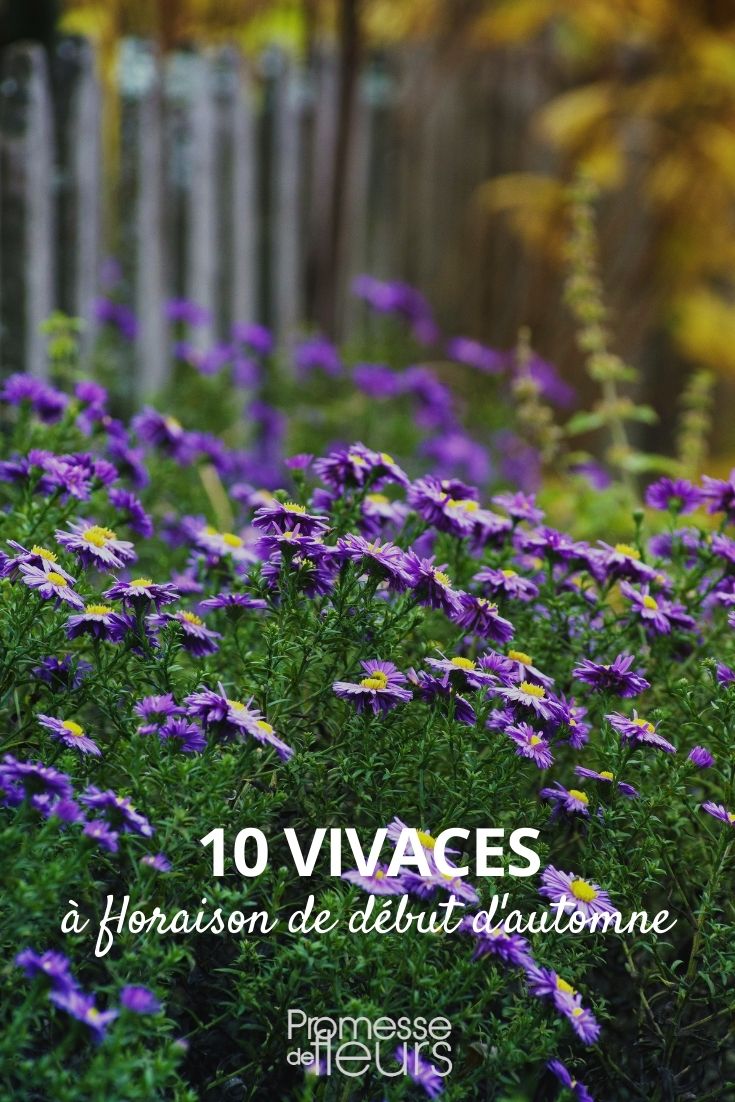


































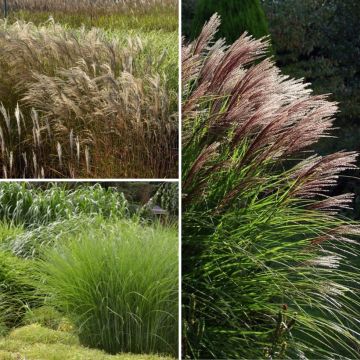
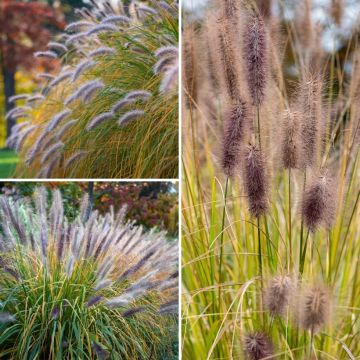
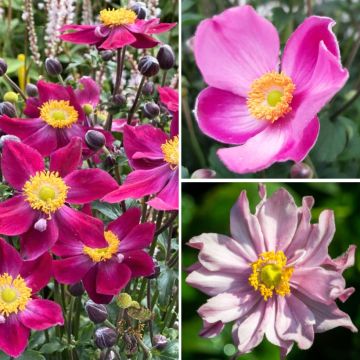
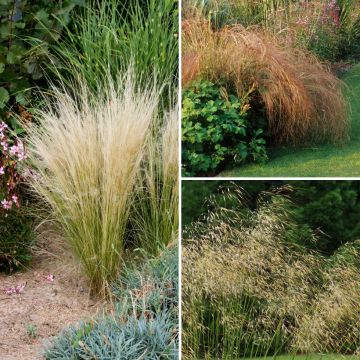



Comments